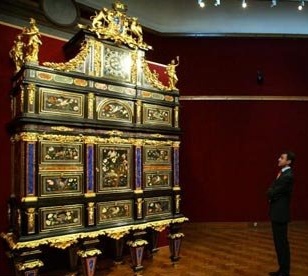A 1732 Florentine Ebony Chest originally made in Italy was purchased for an astonishing $36,000,000. The auction was conducted in London by Christie’s Auction House in 2004. At the time it was the highest price ever paid at an auction for any furniture.
The Florentine cabinet contains amethyst, quarts, chalcedony, jasper, lapis lazuli, agate, pietra dura, embeded scarce rocks and several other valuable stones. The chest has about 10 different drawers surrounded by a black base background. It has beautiful gold and wooden ornaments adorned by blue purplish borders throught the frame. It has some intricately detailed birds and floral designs encrusted in the stones. Additionally it is a very large piece of furniture measuring almost 12 feet tall which stands on 8 different luxurious legs in order to hold its full wiehgt. It is nick-named the Badminton Cabinet since it resided in the city of Badminton for approximately 200 years.
It was originally made in 1732 by Henry Somerset at a young age of 19 years old. He was an English Duke from Beaufort Florence Italy. This particular chest had previously sold in 1990 when Barbara Piasecka Johnson a billionaire from the Johnson and Johnson Family purchased it for a hammer price of $15.1 million. With the buyers premium included it realized an approximate $17,000,000. Also a record price at the time.
Fourteen years later Barbara Piasecka re-consigned it to Chirsite’s Auction House where they resold it in another auction. Prince Hans Adam II from Liechtenstein was the winning bidder. Dr. Johan Kraefter represented the Prince in the auction by placing his winning bid.
By the end of the auction Prince Hans paid a total of $36 million for the chest. This was new record at the time for any piece of furniture. After the auction Prince Hans donated it to the Liechtenstein Museum located in Vienna Australia. Prince Hans happens to be the Director of the Museum.


Leave a Reply
You must be logged in to post a comment.